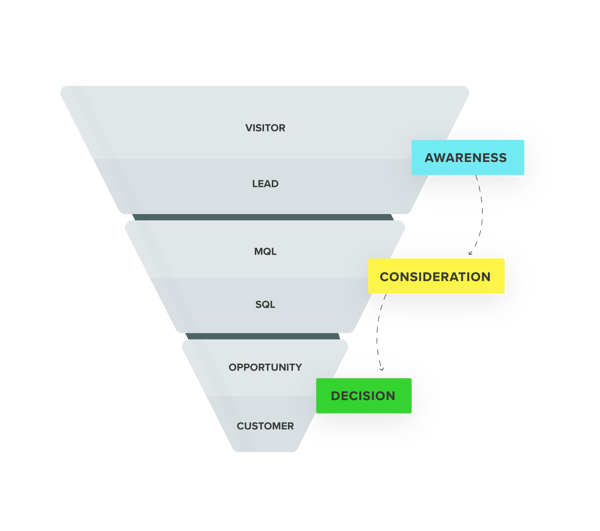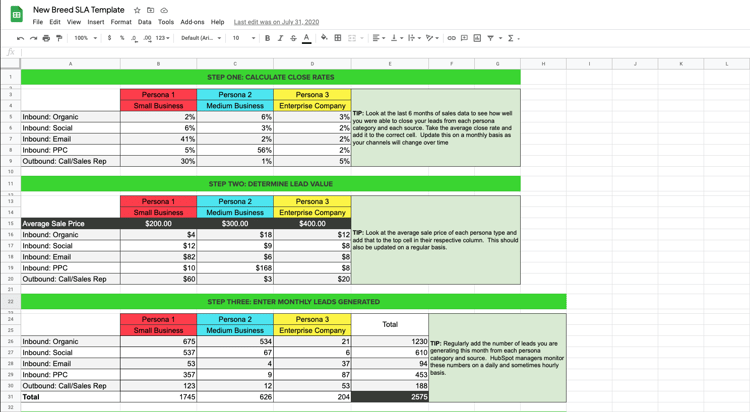Where to Start with Marketing and Sales Alignment
Traditionally the two teams operate separately and have different priorities. But, when that happens, it tends to lead to friction and frustration between the teams and makes it harder for everyone to meet their goals.
Marketing and sales alignment breaks down those barriers, helps teams work together and provides more benefits to the company.
Here are the foundational elements you need to get started:
Goals
Both marketing and sales need to have a common set of goals. Since the work of both teams do should ultimately drive revenue for the company, revenue is the ideal overarching goal, but the steps that need to be taken in order to generate revenue also should be accounted for when setting goals.
In order to reach a revenue goal, you need to close deals. In order to close deals, you need to open opportunities. In order to open opportunities, you need to have qualified leads. In order to have qualified leads you need to convert website visitors into leads. In order to convert website visitors into leads, you need to attract visitors to your website.

That process is measured through the marketing and sales funnel, where visitors enter at the top of the funnel and customers come out the bottom. The number of contacts at each stage and the conversion rates between stages can help you determine if you’re on track to hit your revenue goal.
Marketing and sales teams are typically responsible for different portions of the funnel, with marketing owning the top half spanning visitor to marketing qualified lead and sales managing sales qualified lead through the deal closing. But, both teams should still be working together across all areas of the funnel, and there should be visibility into each other’s performance and goals.
Reaching the goal for each stage of the funnel is dependent upon the success of the stage above it. For example, the less qualified leads marketing produces for sales, the less opportunities sales will be able to open. Using revenue as the main performance measurement encourages collaboration between both teams since they need each other to do well in order to be successful themselves.
Service-Level Agreement (SLA)
Establishing goals is pointless if teams then don’t deliver upon them. One of the most common points of friction between marketing and sales teams is the perception that the other team isn’t doing their job properly.
Sales will think that marketing isn’t creating enough high-fit leads and marketing will feel like sales isn’t doing a sufficient job following up on the leads they provide.
To prevent those disagreements from occurring, you should create a service-level agreement (SLA), which is a contract that holds both teams accountable to agreed upon expectations.

In an SLA, marketing will be assigned a quota for how many qualified leads they need to generate and sales will receive guidelines for the follow-up they do with those leads, like a minimum number of outreach attempts and a timeline for how quickly they need to reach out.
On top of that, SLAs include a definition of what constitutes a qualified lead so that marketing and sales can make sure they are both pursuing the same type of prospects. Define your ideal customer profiles (ICPs) and buyer personas along with what indicates sales readiness.
Technology
Your tech stack should be enabling your marketing and sales teams to achieve their goals and measure their progress. For example, you need to have a way to mark leads as qualified in your CRM and track the outreach sales reps are doing for each contact.
The right automation and software should make it easier for marketing and sales to do their jobs. Instead of telling sales they need to reach out to each lead assigned to them within 32 hours and follow-up at least seven times but leave everything else about remembering to do that work up to them, you can automate notifications and tasks so when a rep is assigned a lead they are instantly notified and have the work they need to do mapped out.
Setting up automated lead scoring can make it easier to determine how qualified a lead is. You can create scores that measure both fit and interest so if a lead comes from a company that matches your ideal customer profile and has engaged with a lot of your content and communications, marketing can determine based on the lead score that that lead is ready to be passed on to sales.
Reporting tools with dashboards can help provide visibility and maintain accountability. For example, you can enable everyone to see what the average number of follow-up messages are, how many uncontacted leads a rep has in their name or how many qualified leads have been generated in the current period.
Feedback
When you’re just starting to align your marketing and sales teams, some of these foundational components will be built using guesswork. Your goals, SLA, ICPs and buyer personas might need to be updated as you see how effective they are. You should revisit them at least once a year.
Reviewing goals and SLAs will fit organically into the annual planning that happens in preparation for each new year and the respective revenue kick off. Re-examining your personas and ICPs all at once can get overwhelming, so it might make more sense to rotate through a couple each quarter.
Ideally just having these alignment systems in place will create better feedback loops and collaboration — but you can’t rely entirely on that. Find a way to require the minimum collaboration you want to see between your teams, like monthly or quarterly joint team meetings.
Takeaway
Marketing and sales alignment isn’t a new concept. It’s something that the majority of companies are now working toward because when your marketing and sales teams are aligned, both teams’ efforts will be amplified.
If you don’t work toward aligning your teams, you will be giving your competitors an advantage over you.
Guido Bartolacci
Guido is Head of Product and Growth Strategy for New Breed. He specializes in running in-depth demand generation programs internally while assisting account managers in running them for our clients.





